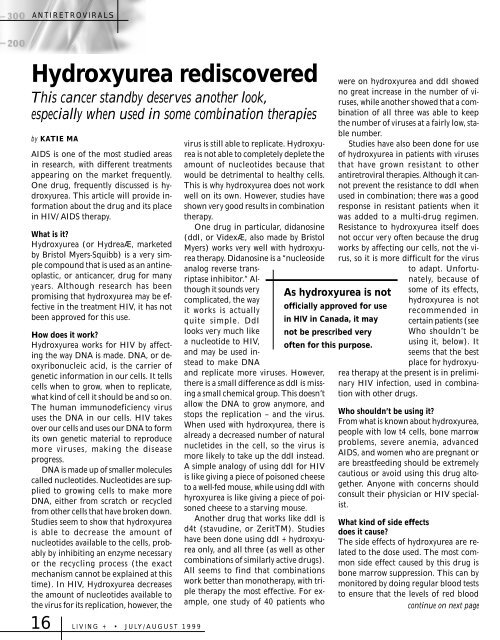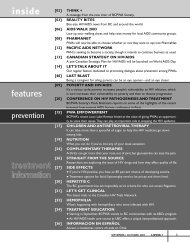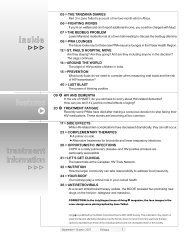Living + Magazine Issue 1 - Positive Living BC
Living + Magazine Issue 1 - Positive Living BC
Living + Magazine Issue 1 - Positive Living BC
Create successful ePaper yourself
Turn your PDF publications into a flip-book with our unique Google optimized e-Paper software.
ANTIRETROVIRALS<br />
Hydroxyurea rediscovered<br />
This cancer standby deserves another look,<br />
especially when used in some combination therapies<br />
by KATIE MA<br />
AIDS is one of the most studied areas<br />
in research, with different treatments<br />
appearing on the market frequently.<br />
One drug, frequently discussed is hydroxyurea.<br />
This article will provide information<br />
about the drug and its place<br />
in HIV/AIDS therapy.<br />
What is it?<br />
Hydroxyurea (or HydreaÆ, marketed<br />
by Bristol Myers-Squibb) is a very simple<br />
compound that is used as an antineoplastic,<br />
or anticancer, drug for many<br />
years. Although research has been<br />
promising that hydroxyurea may be effective<br />
in the treatment HIV, it has not<br />
been approved for this use.<br />
How does it work?<br />
Hydroxyurea works for HIV by affecting<br />
the way DNA is made. DNA, or deoxyribonucleic<br />
acid, is the carrier of<br />
genetic information in our cells. It tells<br />
cells when to grow, when to replicate,<br />
what kind of cell it should be and so on.<br />
The human immunodeficiency virus<br />
uses the DNA in our cells. HIV takes<br />
over our cells and uses our DNA to form<br />
its own genetic material to reproduce<br />
more viruses, making the disease<br />
progress.<br />
DNA is made up of smaller molecules<br />
called nucleotides. Nucleotides are supplied<br />
to growing cells to make more<br />
DNA, either from scratch or recycled<br />
from other cells that have broken down.<br />
Studies seem to show that hydroxyurea<br />
is able to decrease the amount of<br />
nucleotides available to the cells, probably<br />
by inhibiting an enzyme necessary<br />
or the recycling process (the exact<br />
mechanism cannot be explained at this<br />
time). In HIV, Hydroxyurea decreases<br />
the amount of nucleotides available to<br />
the virus for its replication, however, the<br />
virus is still able to replicate. Hydroxyurea<br />
is not able to completely deplete the<br />
amount of nucleotides because that<br />
would be detrimental to healthy cells.<br />
This is why hydroxyurea does not work<br />
well on its own. However, studies have<br />
shown very good results in combination<br />
therapy.<br />
One drug in particular, didanosine<br />
(ddI, or VidexÆ, also made by Bristol<br />
Myers) works very well with hydroxyurea<br />
therapy. Didanosine is a “nucleoside<br />
analog reverse transriptase<br />
inhibitor.” Although<br />
it sounds very<br />
complicated, the way<br />
it works is actually<br />
quite simple. DdI<br />
looks very much like<br />
a nucleotide to HIV,<br />
and may be used instead<br />
to make DNA<br />
and replicate more viruses. However,<br />
there is a small difference as ddI is missing<br />
a small chemical group. This doesn’t<br />
allow the DNA to grow anymore, and<br />
stops the replication – and the virus.<br />
When used with hydroxyurea, there is<br />
already a decreased number of natural<br />
nucletides in the cell, so the virus is<br />
more likely to take up the ddI instead.<br />
A simple analogy of using ddI for HIV<br />
is like giving a piece of poisoned cheese<br />
to a well-fed mouse, while using ddI with<br />
hyroxyurea is like giving a piece of poisoned<br />
cheese to a starving mouse.<br />
Another drug that works like ddI is<br />
d4t (stavudine, or ZeritTM). Studies<br />
have been done using ddI + hydroxyurea<br />
only, and all three (as well as other<br />
combinations of similarly active drugs).<br />
All seems to find that combinations<br />
work better than monotherapy, with triple<br />
therapy the most effective. For example,<br />
one study of 40 patients who<br />
were on hydroxyurea and ddI showed<br />
no great increase in the number of viruses,<br />
while another showed that a combination<br />
of all three was able to keep<br />
the number of viruses at a fairly low, stable<br />
number.<br />
Studies have also been done for use<br />
of hydroxyurea in patients with viruses<br />
that have grown resistant to other<br />
antiretroviral therapies. Although it cannot<br />
prevent the resistance to ddI when<br />
used in combination; there was a good<br />
response in resistant patients when it<br />
was added to a multi-drug regimen.<br />
Resistance to hydroxyurea itself does<br />
not occur very often because the drug<br />
works by affecting our cells, not the virus,<br />
so it is more difficult for the virus<br />
to adapt. Unfortunately,<br />
because of<br />
some of its effects,<br />
hydroxyurea is not<br />
recommended in<br />
certain patients (see<br />
Who shouldn’t be<br />
using it, below). It<br />
seems that the best<br />
place for hydroxyurea<br />
therapy at the present is in preliminary<br />
HIV infection, used in combination<br />
with other drugs.<br />
As hydroxyurea is not<br />
officially approved for use<br />
in HIV in Canada, it may<br />
not be prescribed very<br />
often for this purpose.<br />
Who shouldn’t be using it?<br />
From what is known about hydroxyurea,<br />
people with low t4 cells, bone marrow<br />
problems, severe anemia, advanced<br />
AIDS, and women who are pregnant or<br />
are breastfeeding should be extremely<br />
cautious or avoid using this drug altogether.<br />
Anyone with concerns should<br />
consult their physician or HIV specialist.<br />
What kind of side effects<br />
does it cause?<br />
The side effects of hydroxyurea are related<br />
to the dose used. The most common<br />
side effect caused by this drug is<br />
bone marrow suppression. This can by<br />
monitored by doing regular blood tests<br />
to ensure that the levels of red blood<br />
continue on next page<br />
16 LIVING + • JULY/AUGUST 1999











